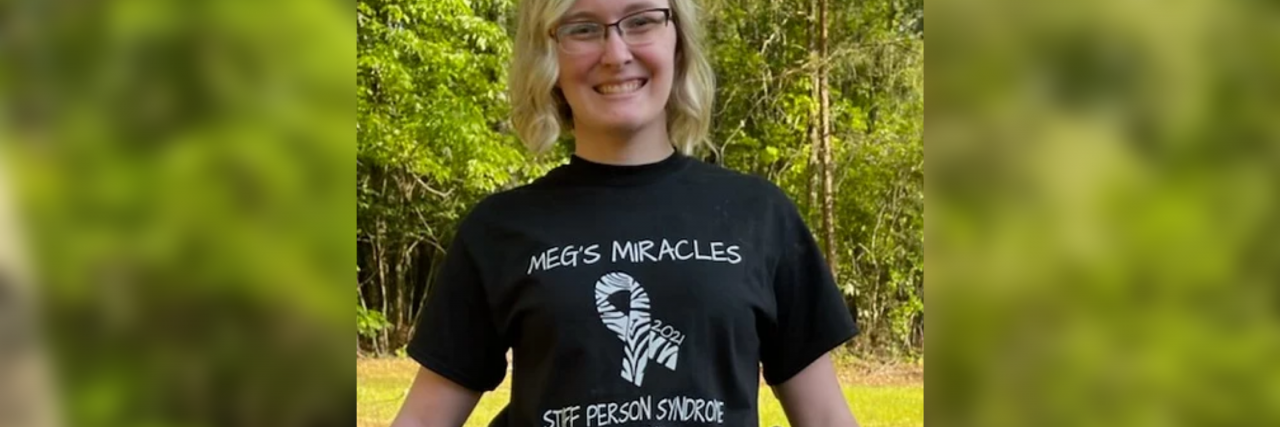“Yes, my backpack contains the charger to my body!”
Oh, sorry! Was that awkward? I tend to do that. As a feeding tube dependent individual, I have my share of funny, messy, and occasionally mortifying moments.
I have “fed the bed” so many times, as many people with feeding tubes do at some point. Nothing like waking up covered head to toe in feeding tube formula. All the “tubie clips” in the world and I always manage to get my slack tubing caught in the car door, around a doorknob, catch it on my wheelchair, get my tubing hopelessly twisted with my IV tubing, or I will plain step on it! The laundry machine always seems to “eat” my favorite tube pads as well… Do you think that they go where socks go to hide? A good conspiracy theory if I say so myself.
Pump goes off during my statistics exam in college? “Meg, you are beeping!” my peers exclaimed. Looking back, it is so easy for me to laugh at those awkward moments with a feeding tube as a teenager and young adult. If you took a good hard look at me, you would not even guess there is a pump in my backpack or a hole in my abdomen straight to my stomach!
I have not been feeding tube dependent my entire life, and so many people think that feeding tubes are for babies, young children, and the elderly. That is just simply not the case. Adolescents and young adults tend to get “lost” in the feeding tube community though. I have a rare neurological, autoimmune disease called stiff person syndrome (SPS). Silly name, but a very serious disease when it affects the function of organs the way it has compromised my stomach and digestive tract. SPS causes the bottom of my stomach, the pylorus, to spasm. It was one of the first ways my SPS manifested itself and it is not a very common way to have the disease process start. I received my first feeding tube at the age of 18.
I will never forget the day I finally decided that I had to join the “Super Tubie Club” and become one of the 300,000 tube-fed individuals in the United States alone. I was laying in the ICU holding room of the Johns Hopkins Emergency Department. My jaw was in spasm to the point that I could not open my mouth. Medications that could only be given to me by mouth were not options and after a year of getting a new feeding tube almost every month, the gastroenterologists started having serious conversations with me about having a surgical feeding tube placed. I was in denial that I was “that sick,” but I quickly realized my body was giving out on me and I needed medical intervention fast. As soon as I said the words giving consent, it triggered a sequence of procedures to get me on the operating room board within 24 hours. I was malnourished and underweight, but some people are overweight and malnourished. Everyone needs sufficient nutrition, no matter their weight.
Unfortunately, I believed many of the myths about feeding tubes, and I mean, who really wants to be connected to an ambulatory feeding tube pump 23 hours a day? My nutritional options are limited to what I can get in a container or can. I learned with time that I could still suck on hard candies or a lollipop to get me through all the times where I want to eat, but I know I will not be able to keep it down. Some people with tubes can eat small amounts by mouth. Some supplement with feeds overnight and eat what they can during the day.
One thing I wish someone would have warned me about was that I was going to be in a significant amount of pain. Now, pain is all relative, but I have spoken with many others that also have surgical tubes and I think that for the most part, we agree it was at least uncomfortable, which leads me to the next myth, there are many different kinds of feeding tubes. Some are inserted through the nose and down to the stomach and/or small intestine. They are typically only used for short periods of time before a doctor may discuss a surgical tube.
Feeding tubes do not always stay in forever. Some people will only need them for a short time and others are lifelong tube-feeders, which means some people live their daily lives outside of the hospital and some only need the tube in a hospital setting. Tube feeding is a life-sustaining therapy, but they are not only given to those that are dying exclusively as end-of-life care. Everyone is different!
Many people see feeding tubes as a scary intervention and well, that is one thing doctors do not tell patients. Being tube fed is a lot of work and it does not always “end your symptoms,” but so is being malnourished, failure to thrive (FTT), and being dehydrated, which is what would happen to me. My feeding tube keeps me out of the hospital. I cannot explain the energizing feeling when my body started to receive adequate nutrition. My feeding tubes have saved my life because they allow me to receive adequate nutrition, hydration, and medication that I crush, dissolve in water, and push through the tube. I hope I was able to bust some feeding tube myths from my experience.

